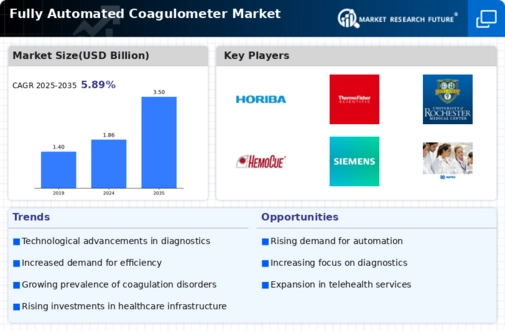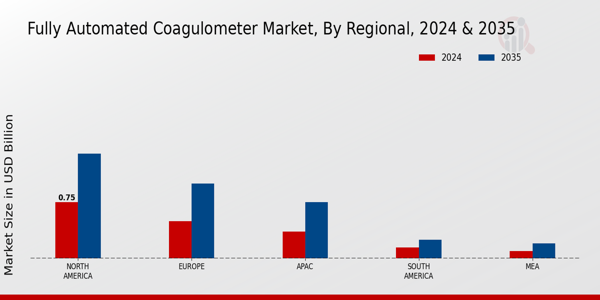Market Growth Projections
The Global Fully Automated Coagulometer Market Industry is projected to experience substantial growth over the next decade. With an estimated market value of 1.86 USD Billion in 2024, it is expected to reach 3.5 USD Billion by 2035. This growth trajectory suggests a robust compound annual growth rate (CAGR) of 5.92% from 2025 to 2035. Factors contributing to this growth include technological advancements, increasing prevalence of coagulation disorders, and the rising demand for point-of-care testing solutions. The market's expansion reflects the ongoing evolution of coagulation diagnostics and the increasing importance of accurate testing in clinical practice.
Technological Advancements
The Global Fully Automated Coagulometer Market Industry is experiencing rapid technological advancements that enhance diagnostic accuracy and efficiency. Innovations in microfluidics and automation are leading to the development of coagulometers that require minimal user intervention, thereby reducing the potential for human error. For instance, the integration of artificial intelligence in coagulometers allows for real-time analysis and interpretation of coagulation data. This trend is expected to drive market growth, as healthcare facilities increasingly adopt these advanced systems to improve patient outcomes and streamline laboratory workflows.
Regulatory Support and Standardization
The Global Fully Automated Coagulometer Market Industry is positively impacted by regulatory support and standardization initiatives aimed at improving diagnostic accuracy and patient safety. Regulatory bodies are increasingly establishing guidelines for the use of automated coagulometers in clinical settings, ensuring that these devices meet stringent performance criteria. Such regulatory frameworks foster confidence among healthcare providers and encourage the adoption of fully automated systems. As a result, the market is likely to experience sustained growth, driven by the assurance of quality and reliability in coagulation testing.
Increased Focus on Point-of-Care Testing
The Global Fully Automated Coagulometer Market Industry is witnessing a shift towards point-of-care testing (POCT), driven by the need for rapid diagnostic solutions. POCT allows for immediate results, facilitating timely clinical decisions, particularly in emergency settings. Fully automated coagulometers are increasingly being integrated into POCT environments, enhancing their utility in various healthcare settings. This trend is expected to propel market growth, as healthcare systems prioritize efficiency and patient-centric care. The market is anticipated to reach 3.5 USD Billion by 2035, reflecting the growing adoption of POCT solutions.
Rising Prevalence of Coagulation Disorders
The Global Fully Automated Coagulometer Market Industry is significantly influenced by the rising prevalence of coagulation disorders, such as hemophilia and thrombosis. According to health statistics, the incidence of these disorders is increasing globally, necessitating efficient diagnostic tools. Automated coagulometers provide rapid and accurate results, which are crucial for timely treatment. As healthcare providers seek to enhance patient care, the demand for fully automated systems is likely to grow. This trend is projected to contribute to the market's expansion, with an estimated value of 1.86 USD Billion in 2024.
Growing Demand for Home Healthcare Solutions
The Global Fully Automated Coagulometer Market Industry is also benefiting from the growing demand for home healthcare solutions. Patients with chronic conditions, such as anticoagulation therapy, require regular monitoring of their coagulation status. Fully automated coagulometers designed for home use enable patients to conduct tests conveniently, thus improving adherence to treatment regimens. This shift towards home healthcare is likely to drive market growth, as it aligns with the broader trend of personalized medicine. The market's expansion is expected to be supported by a projected CAGR of 5.92% from 2025 to 2035.
























